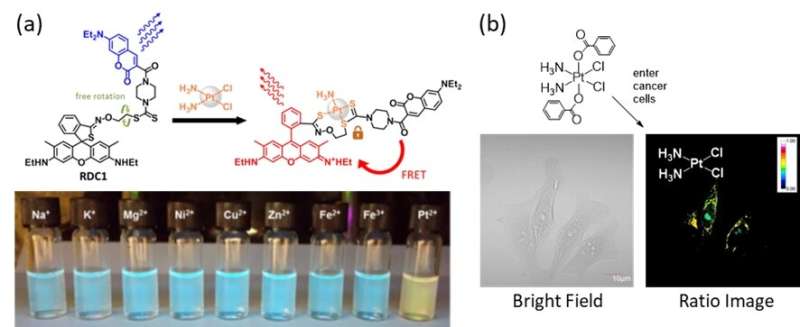A ratiometric fluorescent probe for cisplatin

NUS chemists have developed a novel ratiometric fluorescent probe for studying cellular activity of the clinically important anticancer drug cisplatin for next generation drug development.
Since its discovery in 1965, cisplatin has become one of the most important chemotherapeutic agents in clinical use. It is part of a class of platinum(II) anticancer agents and is being used widely to treat a variety of malignancies such as testicular, ovarian and colorectal cancers. The next generation of platinum anticancer agents (prodrug complexes) that is being investigated in clinical trials uses platinum(IV) scaffolds. These agents are biologically inactive compounds which can be metabolised in cancer cells to produce bioactive platinum(II) agents. These new drug candidates can overcome the drawbacks of traditional platinum(II) agents such as high toxicity and other severe side effects. However, their biochemical interaction with cancer cells to produce their pharmacological effect at the cellular level is not clear.
Prof Ang Wee Han and his research team from the Department of Chemistry, NUS have developed a ratiometric fluorescent probe, known as RDC1, that is able to detect and measure cisplatin effectively in a complex cellular environment containing an assortment of many other metal ions and biomolecules. The usual method of quantifying cisplatin is to measure the platinum content in cancer cells through elemental analysis but the method is destructive and does not distinguish one form of platinum from another. RDC1 is designed to differentiate cisplatin from its structurally-similar platinum(IV) analogues for fluorescence imaging at the cellular level. As a ratiometric probe, RDC1 changes emissions/colours between two emission/colour channels as more cisplatin is detected. This is a more accurate way of quantifying minute amounts of analyte compared to single emission/colour intensity-based probes because detectors perceive emission/colour changes more acutely than intensity changes.
Using RDC1 in their laboratory experiments, Prof Ang and his team visualised the conversion of platinum(IV) prodrug complexes within cancer cells and found that they are activated by a chemical reduction process to produce cisplatin. They also found that glutathione, a cellular antioxidant found in our bodies, is not the dominant biomolecule affecting this chemical reduction process, which is contrary to many research reports. This explains why earlier attempts to develop platinum(IV) prodrugs targeting glutathione reduction have not been successful.
Prof Ang said, "We believe that RDC1 is a useful tool which can empower researchers to better understand the way platinum(IV) prodrug complexes are processed at the cellular level. These insights can pave the way for the design of more effective anticancer drugs."
Moving forward, the team is developing new derivatives of the probe that can pinpoint cisplatin compartmentalisation within cancer cells with good precision.
More information: Jun Xiang Ong et al. A Ratiometric Fluorescent Probe for Cisplatin: Investigating the Intracellular Reduction of Platinum(IV) Prodrug Complexes, Angewandte Chemie International Edition (2018). DOI: 10.1002/anie.201810361
Diego Montagner et al. A Fluorescent Probe for Investigating the Activation of Anticancer Platinum(IV) Prodrugs Based on the Cisplatin Scaffold, Angewandte Chemie International Edition (2013). DOI: 10.1002/anie.201305734



















